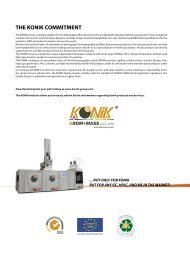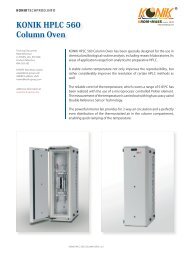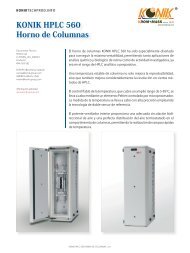Konik Consumables Catalogue_redistribucion y capitulos 1 y 2 ...
Konik Consumables Catalogue_redistribucion y capitulos 1 y 2 ...
Konik Consumables Catalogue_redistribucion y capitulos 1 y 2 ...
Create successful ePaper yourself
Turn your PDF publications into a flip-book with our unique Google optimized e-Paper software.
GC CAPILLARY & PACKED COLUMNS<br />
KONIK CAPILLARY COLUMNS<br />
All of KONIK columns are manufactured according to a strict established protocol, and within the<br />
ISO 9001:2008 quality rules.<br />
• Step 1: Hydrothermal treatment<br />
• Step 2: Deactivation process<br />
• Step 3: Wetting, bonding and crosslinking<br />
• Step 4: Quality control<br />
Step 1: Hydrothermal Treatment<br />
KONIK starts its manufacturing process with the selection of the best possible fused silica tubing.<br />
This tube presents an extremely reduced tolerance of internal diameters and has a polyimide outer<br />
coating capable of withstanding the highest temperatures without loss of its exible mechanical<br />
characteristics. Each one of the batches of silica used in the process is conveniently characterized<br />
as an essential step to set the Hydrothermal Treatment conditions (Fig. 1) that will give rise to<br />
a surface containing a high and constant density of silanol groups, which will later be properly<br />
deactivated.<br />
This treatment is indispensable, as the different capillary tubing manufactured batches present<br />
a very low and irregularly distributed silanol group density due to the high temperature<br />
manufacturing process (~2000ºC).<br />
1 - 2-Octanone<br />
2 - C-10<br />
3 - 1-Octanol<br />
4 - C-11<br />
5 - 2,6-Dimethylphenol<br />
6 - 2,6-Dimethylphenol<br />
7 - C-12<br />
8 - C-13<br />
Step 2: Deactivation Process<br />
The deactivation process, which is different for each type of stationary phase, is carefully<br />
controlled (Fig. 2), ensuring that the tubing surface has acquired the necessary chemical<br />
inertness and surface tension in order to be able to proceed with the second stage of stationary<br />
phase deposition. This step also facilitates the introduction of specic functional groups on the<br />
tubing wall which are very useful for the later binding of the stationary phase or to give the columns<br />
a given end point characteristics.<br />
Step 3: Wetting, bonding and crosslinking<br />
Verication of Hydrothermal Treatment<br />
1 - 2-Octanone<br />
2 - C-10<br />
3 - 1-Octanol<br />
4 - C-11<br />
5 - 2,6-Dimethylphenol<br />
6 - 2,6-Dimethylphenol<br />
7 - C-12<br />
8 - C-13<br />
TKG 1096<br />
Deactivation Stage (Intermediate Test)<br />
Stationary phase selection for optimum wetting of the column is a critical point in regards to<br />
column quality. The column manufacturer uses extremely pure polymers for its phases, in order to<br />
guarantee that our columns will respond to the requirements that our customers expect in terms<br />
of efficiency, reproducibility, stability and minimal bleeding.<br />
The polymers used are carefully fractionated to eliminate the low molecular weight components<br />
and trace catalyst. This results in a higher thermal stability and lower bleeding. Then, these polymers<br />
are tested by means of spectroscopic (FTIR, UV, NMR), chromatographic (GPC) techniques and by<br />
differential thermal analysis.<br />
Fig. 3 shows the molecular exclusion chromatography of the polymer TRB-5 with its corresponding<br />
thermogravimetric curve in Fig. 4.<br />
The crosslinking and bonding of the stationary phase is achieved by avoiding the use of peroxides<br />
which are the cause of many of the problems related to residual activity due to phase degradation<br />
and thermal instability exhibited in numerous imported columns.<br />
The fact that a given stationary phase is crosslinked and/or chemically bonded to the capillary<br />
tube inner wall allows, if necessary, the recovery or regeneration of an accidentally contaminated<br />
column by washing it with the adequate series of solvents.<br />
GPC Chromatogram of KAP-5 polymer<br />
Cap. 1: 2<br />
<strong>Konik</strong>-Tech












